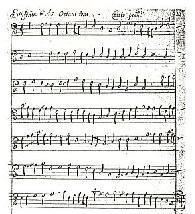Name Leonora Duarte Role Composer | ||
 | ||
Leonora duarte sinfonia no 1
Leonora Duarte (1610 – 1678?) was a Flemish composer and musician, born in Antwerp. She belonged to a wealthy Portuguese-Jewish family who were marrano, meaning they outwardly acted as Catholics while secretly maintaining their Jewish faith and practices. She was baptized on 28 July 1610.
Contents
- Leonora duarte sinfonia no 1
- Sonnambula teju cole leonora duarte 1610 1678
- Family
- Biography
- Composer
- Death
- References
Having been one of the six siblings, in the well known musical family of the Duartes, Leonora composed seven sinfonias which happen to be the only records of music written for viol by a woman in the 17th century.
The Duarte home was a center for music-making and had contact with many important families in the Low Countries and England, including one of the most influential Dutchman of all time in, regards to art and culture, Constantijn Huygens. Duarte wrote for violconsort. Her surviving compositions include seven fantasies for a consort of five viols.[1]
Sonnambula teju cole leonora duarte 1610 1678
Family
Duarte belonged to a well-known Antwerp family of rich jewelers and diamond merchants of Portuguese-Jewish (marrano) origin. The Duarte family left Portugal and settled in Antwerp to escape the infamous Inquisition. Her parents were Gaspar Duarte and Catharina Rodrigues, and she had three sisters and two brothers.
Gaspar Duarte, although played the harpsichord and was musically trained, as well as his wife, was furthermore a successful jewelry merchant, especially in diamonds, who built a career in commerce with his son, Diego Duarte. Gaspar was also very close friends with renowned makers of harpsichords, Ruckers and Couchet. The Duarte family residence at the Meir in Antwerp was a well-known centre for music and the visual arts. The correspondence of Leonora’s father and her brother Diego with Constantijn Huygens shows that there were frequent contacts with the cultural élite of the Low Countries and England, including Huygens himself and his sons Constantijn and Christiaan, and William Cavendish, Duke of Newcastle. In 1644 Nicholas Lanier visited the family when he was in voluntary exile, and in 1653 Anne and Joseph de la Barre paid a visit when travelling from Paris to Stockholm.[2]
Biography
Duarte was a Jewish Converso born in Antwerp to a prominent family of merchants and art collectors who were friends of the keyboard-making Ruckers family, Vermeer, and possibly Rubens. Growing up as conversos in her family’s home, there seemed to be an interesting balance of understanding her identity, both as a Jewish woman at core, but also as a Jewish woman composer during the Baroque period. On one hand, marranos, were closely observed, while on the other hand, it seems her family, especially her father, made it be known that regardless of their practices, their family was successful and otherwise great patrons of the arts and cultures. Duarte received a superb musical education that included instruction on viol, virginals, and lute, as well as lessons in composition. Her musical evenings at home with her siblings quickly became well-known ports of call for traveling diplomats and literati, among them Constantijn Huygens, Dutch poet Anna Roemers Visscher, composer Nicholas Lanier, and singer Anne de la Barre. Their family home was known for a remarkable appreciation for guests and personal musical performances by all members of their family.
Composer
As a young composer, Leonora Duarte wrote a set of seven abstract fantasies (one in two parts), written for five viols. These seven short pieces are in the late Jacobean style and called ‘Symphonies’. Her brother, Diego Duarte, set to music various poems by William Cavendish (1650s) and later the psalm paraphrases of Godeau (1673–85), which he dedicated to Constantijn Huygens. None of these works, possibly all for one voice with basso continuo, has survived today.
Leonora Duarte was never commissioned by the church or the court over her lifetime, but stood out in her musical family due to her compositional talent. Her father, Gaspar, was influenced so much by her work, that he hired a professional to transcribe her work and published in on his behalf.
Leonora was capable of combining her native talent with the latest ideas and theory in Italian and French music due to the rich traffic of visitors from all parts of Europe that regularly made it to the Duarte’s house on the Meir. Historical documentation provides ample evidence that the Duarte family entertained important relations with the great Dutchman, Constantijn Huygens. Influences can be noted and applied, regarding the Duarte family and their guests which at one time included, Dirk Sweelinck, son of Jan Pieterszoon Sweelinck, the Dutch composer whose work helped mark the transition between the Renaissance and Baroque periods of music.
Leonora’s seven short sinfonias reflect the creation and compositional workings of Baroque music within the domestic sphere, where it would have originally been heard and performed.
Death
It is unknown what month, or even year, of Leonora’s death but can be recorded around 1678. Leonora was one of three daughters of the Duarte family to die from Antwerp’s plagues. The year of her death is supported by city records of the event.
Her brother Diego died in 1691 without successors, which ended the Duarte family.
